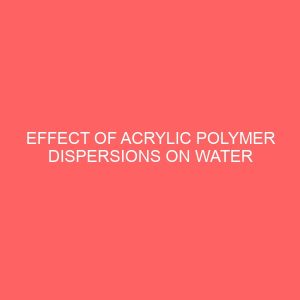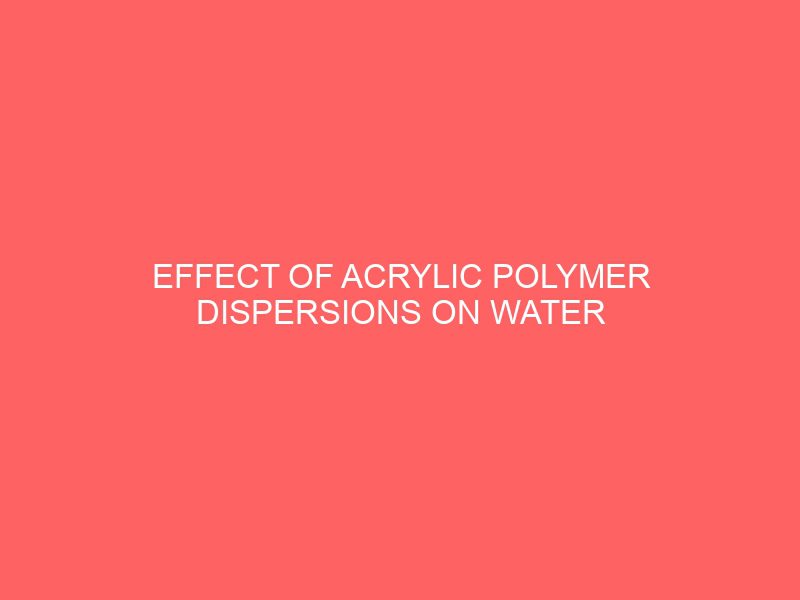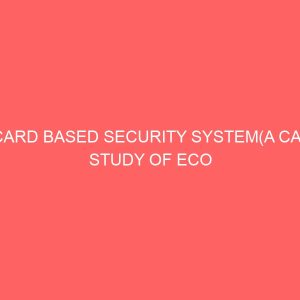Description
CHAPTER ONE
1.0 INTRODUCTION
Acrylics are esters of acrylic acids, which are the products formed by the reaction of an acrylic acid and alcohol. The esters of acrylic acid polymerise readily to form exceptionally clear plastics. These are widely used in applications requiring clear durable surfaces, e.g. in the aircraft and automobile industries. In more common use are surface coatings involving acrylics. The physical properties of acrylics (such as gloss, hardness, adhesion and flexibility) can be modified by altering the composition of the monomer mixture used in the polymerisation process. Acrylics are used in a wide range of industries, and the list below is simply a selection of some of the more common examples: Adhesives, textile industry (e.g. making sponge fill used in padded
jackets), paper coatings, paint industry particularly in paints used for road markings.
The polymerisation process proceeds readily in the presence of catalysts and may be carried out in any one of four different ways: emulsion, bulk, solution or in suspension.
Emulsion polymerisation occurs in a water/monomer emulsion using a water-soluble catalyst. Emulsion polymerisation is the main process used in the production of acrylic polymers.
Bulk polymerisation is carried out in the absence of any solvent. The catalyst is mixed in with the monomer and the polymerisation is then left to occur with time. This is the method commonly used to manufacture acrylic sheets.
Solution polymerisation is carried out in a solvent in which both the monomer and subsequent polymer are soluble. Only low molecular weight polymers can be manufactured by this process, as high molecular weight polymers cause very high viscosities.
Suspension polymerisation is carried out in the presence of a solvent usually water, in which the monomer is insoluble, and in which it is suspended by agitation. To prevent the droplets of
1
monomer from coalescing and also to prevent the polymer from coagulating, protective colloids are added. Suitable colloids include bentonite, starch, polyvinyl alcohol and magnesium silicate. In contrast to emulsion polymerisation the catalyst is monomer-soluble and is dissolved in the suspended droplets. The polymers are manufactured from monomers that are formed from the reactions of acrylic acids with alcohols. These are then polymerised using a radical initiator in a water emulsion.
The following components are needed for the emulsion polymerisation reaction: Monomer
Monomers are prepared by a reversible reaction between an acrylic acid and an alcohol:
CH2= CR-COOH + R’ OH CH2=CR-COOR’ + H2O
Acrylic acid alcohol alkyl acrylate
The major monomers used are ethyl acrylate, methyl methacrylate and butyl acrylate, as well as non-acrylic monomers such as vinyl acetate and styrene which behave similarly.
Surfactant
A surfactant is a substance composed of mutually repellent polar and non-polar ends. The surfactant surrounds each monomer droplet with a layer of surfactant with the polar tails oriented towards the surrounding water thus forming a micelle.
Water
Water is used as the medium to disperse these micelles. During the process the water acts as a solvent for the surfactants and initiators, as well as a heat transfer medium.
2
Initiator
The initiators (catalysts) usually used are water soluble peroxidic salts such as ammonium or sodium peroxydisulfate. The reaction can be initiated either by thermal or redox initiation.
In thermal initiation the peroxydisulfate dissociates to give two SO4-radicals.
-O3S?O?O?SO3- ? 2SO4- ?
Peroxydisulfate sulfate radical
In redox initiation a reducing agent (usually Fe2+or Ag+) is used to provide one electron, causing the peroxydisulfate to dissociate into a sulfate radical and a sulfate ion:
Fe2+ + -O3S?O?O?SO3- ? Fe3+ + SO4- ? + SO42-
Peroxydisulfate sulfate radical
The emulsion polymerisation process can be carried out in a reaction kettle, which is fitted with a jacket for heating and cooling to allow control of temperature during the reaction.
Surfactant and water are first charged into the kettle. The monomer emulsion and initiator solution (containing redox agents to split the persulphate into sulphate radicals) is then transferred from the monomer feed tank into the kettle at a controlled rate. The mixture in the kettle is constantly agitated while the monomer is being added. During this time the monomer polymerises in accordance with the reactions given below:
.SO4 + CH2=CRCOOR? -OSO3 CH2 RC.COOR?
Monomer monomer radical
. .
SO CH C(COOR’) +CH=RC (COOR’)
4 2 2
Monomer radical
-SO CH -RC(COOR’)CH 2 RC. COOR’ 4 2
Dimer radical







